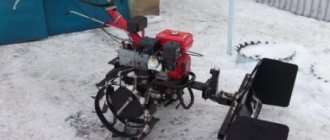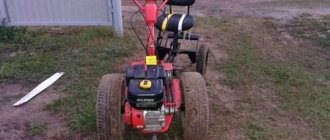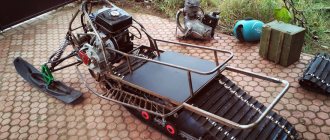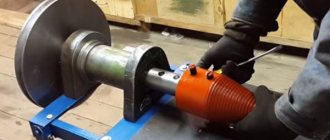Motoblock device
The walk-behind tractor consists of a gasoline engine or electric motor, a control system, transmission, aggregation system and chassis.
Engine
The units use both two-stroke and four-stroke engines . They are equipped with devices that automatically regulate the rotation speed, which simplifies the operator’s work. The engine power of light walk-behind tractors and walk-behind cultivators is up to 5 liters. s., and for heavy ones (actually walk-behind tractors) - up to 10 liters. With. Higher power engines are rarely used.
Transmission
This device is installed on walk-behind tractors in various technical solutions. The most common transmissions :
- Gear is a standard tractor transmission. It contains only gear-type transmissions with reverse and several stages. The clutch is controlled separately. The crankshaft is located perpendicular to the drive axis in a horizontal plane. There is a shaft for power take-off.
- Gear-worm . Consists of an upper gear reducer and a lower worm gear. It has a vertical crankshaft arrangement. Equipped with an automatic centrifugal clutch. It has a pulley or shaft for power take-off. This transmission is very compact. Used on light walk-behind tractors and cultivators.
- Belt-gear-chain . The gearbox shaft rotates using a belt drive, which also serves as a clutch. Agrotechnical clearance is increased due to chain transmission. The crankshaft is placed horizontally, parallel to the drive axis. The drive pulley is equipped with an additional pulley for power take-off. The belt drive can serve as a variator and reverse. The gear part of the gearbox can be either single-stage or two-stage.
- Hydraulic displacement is a new and more expensive type of transmission that allows for smooth adjustment of the traction force and speed of the walk-behind tractor. Very easy to manage.
Aggregation system
An important element designed to interface the walk-behind tractor with agricultural implements . Motor-cultivators are equipped to install implements on the drive axle, and for walk-behind tractors they are mounted on a special bracket. In addition, many products have power take-off devices, with the help of which the active working parts of mounted implements are activated.
Control system
For convenience, almost all controls are located on the handles or steering rods of the walk-behind tractor. On the block units themselves there are located: turning on the power take-off, adjusting the carburetor damper, etc. The clutch control is located on the left handle, and the “gas” is located on the right. Light walk-behind tractors and cultivators are not equipped with brakes. On heavy ones, the brake control is transferred to the right handle.
DIY unit construction
Despite the fact that the cost of such a device is many times less than a full-fledged tractor, not every summer resident or village resident can afford to buy a factory-assembled walk-behind tractor. Prices for branded products range from 30 to 200 thousand rubles. The cheapest ones are Chinese-made units, the reliability of which is extremely questionable.
Assembling a homemade walk-behind tractor with your own hands is a profitable option. The required costs, given the presence of most spare parts, which are usually always available on private farms, will be minimal, and the quality is no worse than the factory one.
Required components
Before starting assembly work, you should decide what rated power the homemade walk-behind tractor will have. The best option is to use an IZH Planet 5 motorcycle or a powerful chainsaw, for example, a Ural, as a spare parts donor. But any similar engines can be used.
To assemble a homemade walk-behind tractor you will need:
- blueprints;
- welding machine;
- set of tools;
- steel pipes;
- car wheels or sheet metal;
- donor (motorcycle or chainsaw).
During the work, additional parts will be required to connect the engine and frame. Attachments can be used from the factory or made independently from available materials.
Frame making
Since in each specific case the design of the unit may differ depending on the parts and engine used, before starting assembly you need to draw up a work plan and make the necessary design drawings, based on the operating manual of the factory walk-behind tractor.
The general principles and procedure for the manufacture of a supporting structure are as follows:
- Metal pipes are connected in the form of two spars with edges curved upward.
- A motorcycle handlebar is welded to these edges. It will be used to control the walk-behind tractor.
- Transverse steel reinforcements are welded to the side members. They will serve as a support for the transmission and engine.
- A metal plate is welded to the rear edge of the structure on which the battery will be mounted.
In addition, you can use a ready-made motorcycle frame, slightly modifying it. You will need to remove the front fork and all parts that interfere with the installation of new equipment. A mount for the hitch should be welded behind it.
With this option, they usually immediately install the wheels from the car, adding an axle made of solid round timber to the design.
Creation of the power section
Regardless of whether the motorcycle engine is installed on a walk-behind tractor, a scooter or a chainsaw, they all must have active air cooling. To make starting easier, it is necessary to change the power system by replacing the fuel supply valve with a petal one.
They use a motorcycle muffler or make it themselves from a pipe with a diameter of 70 mm. To do this, you need to cut off a small part about 25 cm long and fill it with sawdust and shavings. The outlet hole must be narrowed by half.
The muffler must be positioned so as to completely ensure exhaust gases are removed away from the person who will operate the walk-behind tractor. A separate steel structure is assembled for the engine from pipes with a diameter of 42 mm. Externally, it should resemble a sled with brackets having holes for bolts, with which it is attached to the main frame.
Main nodes
In addition to wheels, an engine and a frame, a multifunctional walk-behind tractor must be equipped with additional components, without which it is impossible to perform a number of basic tasks, and its use will be limited to simple transportation of goods.
The speed reducer is a gearbox element that makes it possible for the unit to operate at the lowest speed. In factory models, the speed reducer is installed on the gearbox; accordingly, this must be done on a homemade walk-behind tractor. When planting or harvesting potatoes, sowing or plowing, the power plant requires maximum power at the lowest speeds. It will not be possible to achieve such an effect without installing this node.
A gearbox is a mechanism that ensures the transmission of engine torque to individual components that drive the walk-behind tractor. Install it between the wheels of the unit and the engine.
When working with some additional equipment, torque is transmitted directly to it. If a drill, cutter, snow blower or tracks are installed, the gearbox begins to work directly with them. Without the appropriate experience and knowledge, you should not try to assemble and install this unit yourself: it is better to purchase it in a store or remove it from old equipment.
Attachments
The walk-behind tractor is a multifunctional unit and, in addition to cultivating land plots, it is actively used for cleaning areas, transporting goods and mowing grass. Using a bracket installed on the back of the frame, the following are attached to it: a plow, a harrow, a rake, a milling cutter, a digger, a bulldozer knife, rollers, brushes and other devices.
Many models, including homemade ones, are equipped only with a steering wheel. In this case, the person walks behind the walk-behind tractor while performing work. However, if necessary, an adapter can be made that will allow you to operate the unit while sitting.
For the adapter you will need:
- steel sheet;
- seat;
- a pair of wheels;
- pipe;
- hitch;
- tools and welding machine.
At the end of a rectangular pipe, 1.7 m long and 6 cm wide, 4 cm high, you need to weld a half-meter pipe on which the wheel stands will be located. The height of these racks from the mount to the center of the axis is 35 cm . The seat can be of any design , but should not exceed dimensions of 45x45 cm.
After assembling and installing the wheels, the attachment control is attached to the frame and the structure is connected to the walk-behind tractor using a hitch.
Principle of operation
With the help of the engine , a force is created that drives the walk-behind tractor and is transmitted to agricultural implements.
The main mechanism of a motor cultivator is a rototiller . It is used for plowing, killing weeds, and adding fertilizer to the soil. Moreover, the wider the rototiller, the less time and effort is spent on cultivating the area.
For heavier walk-behind tractors, you can use many types of attachments , which significantly expands the functions of the device. Additional equipment or modifications of walk-behind tractors include:
- cultivator;
- plow;
- hiller;
- trailer;
- snow blower;
- electric generator;
- mower;
- conveyor;
- pump and others.
What is it used for?
Some people don’t know why this unit is so popular.
walk-behind tractor , together with a special adapter, is easy to operate. Indeed, it is widely used in agriculture on plowed or virgin land.
You can also attach a blade that allows you to remove snow in the winter season.
It is important to remember that such a homemade small tractor will allow you to perform a number of jobs: plowing the land, cultivating a plot, hilling vegetables, removing garbage or collecting snow.
If you make up your mind and still build a front adapter for the Neva walk-behind tractor with a steering wheel installed, then all the work in the garden will be done more conveniently and quickly.
Full
This device also comes with all-wheel drive.
In this case, the unit can be located in front or behind. However, a significant difference in characteristics from the above-mentioned varieties is that four wheels are simultaneously involved in the work. This design is more reminiscent of a miniature tractor.
Important! This drive is the most powerful, although not popular.
Kinds
Motoblocks can be:
- household;
- professional;
- semi-professional.
This distinction is usually based on engine power and design reliability. Professional equipment is much more expensive than household equipment, but can treat a large area. In addition, such walk-behind tractors can be specialized for working on very narrow areas or surfaces with large slopes.
It is generally accepted to divide walk-behind tractors by power (although formally the division is related to weight):
Ultralight ones weigh less than 20 kg and motor power is no more than 2 liters. With. They are used for processing small areas and greenhouses with a loosening depth of up to 15 cm and a width of the processed strip up to 0.3 m. They are easy to transport in a passenger car.
The lungs weigh up to 50 kg and the power reaches 4 liters. With. The land is cultivated to a depth of about 20 cm. They can be used in vegetable gardens and personal plots of less than 16 acres.
Medium walk-behind tractors weigh up to 100 kg, while the power reaches 7 liters. With. This makes it possible to deep loosen with a wide strip, but the maneuverability of such a device is sharply reduced. The average unit can be used on plots of up to 50 acres.
Heavy devices weighing up to 130 kg have a power of over 9 liters. With. Designed to work on areas of up to 1 hectare or more. The speed of walk-behind tractors reaches 12 km/h. They can always be equipped with many different additional devices and tools. They belong to professional equipment and can be used on farms and agricultural enterprises. They are unsuitable for working in narrow strips in gardens, orchards and between rows.
Recent Entries
Chainsaw or electric saw - what to choose for the garden? 4 mistakes when growing tomatoes in pots that almost all housewives make Secrets of growing seedlings from the Japanese, who are very sensitive to the soil
the aggregation method is also used :
Motor cultivators . They have agricultural implements (tiller, weeder, etc.) installed on the drive axle instead of wheels.
Wheeled walk-behind tractors . With these devices, an agricultural implement (for example, a homemade plow) works by applying traction force, which is created by the chassis on wheels.
Homemade trailer
A trailer can be made in several ways and using different materials. As a rule, homemade structures are made from a metal frame and wood.
Procedure:
- Make a carrier consisting of a drawbar and a rotating body. Connect to the frame so that the hinge is inside the tubular body.
- Make the frame according to pre-drawn drawings from a pipe with a diameter of 60 mm. Sheath it with wood or metal sheet.
- Using a solid metal axle, install car wheels on the structure.
- Assemble a driver's seat from wood.
The tailgate of the trailer is hinged to facilitate loading and unloading. Metal reinforcements are welded on the sides. The trailer is painted and connected to the walk-behind tractor.
Application
Motor-cultivators and wheeled walk-behind tractors are used for plowing and hilling in small and medium-sized plots, in gardens, greenhouses and flower beds;
for mowing grass, applying fertilizers, weeding, snow removal; as a drive for other tools, machines and energy generation; for transporting small loads over short distances (when using a trailer). At the same time, ultra-light and lightweight walk-behind tractors are , as a rule, equipped only with a cutter and a weeder, and with a hiller only in some cases.
Medium walk-behind tractors have removable wheels and are equipped with a fairly large selection of implements (mill, plow, harrow, hiller, mower), as well as a semi-trailer with a load capacity of up to 500 kg.
Heavy devices are equipped with non-replaceable wheels. The kit includes:
- plow and cutter;
- devices connected to the drive;
- cultivator;
- rake;
- harrow;
- mower;
- snow blower;
- bulldozer blade;
- water pump;
- powerful semi-trailer.
Walk-behind tractor: search for power plant
The simple design of the walk-behind tractor allows you to assemble it from scratch, borrowing various parts from donor units.
For example, the following have proven themselves well as a power plant:
- Chainsaw motor;
- Engine from small and medium-sized motorcycles - “Ant”, “Riga”, “IZH”, “Dnepr”;
- Engine from ZAZ, VAZ cars.
The first option produces power that is more akin to a cultivator, and not like a video on how to make a walk-behind tractor with your own hands, where a large unit sets the rhythm for equally large wheels.
Therefore, when choosing a power plant for a future walk-behind tractor, you must be guided by the area that it will have to process.
Selection rules
When purchasing equipment, first of all, you should decide on its class and power. The larger the area of land to be cultivated, the greater the load on the walk-behind tractor. This means that the heavier and more powerful unit will be required.
You also need to take into account the width and depth of plowing. Even for units of the same class, they can differ greatly. The wider the loosening strip, the faster the device will process the required area.
If you don’t want to limit yourself to simple loosening, then you definitely need to purchase equipment equipped with a power take-off shaft. This makes it truly universal.
You also need to decide on the transmission. For small areas that will not create a serious load on the device, a belt is also suitable. For more complex tasks, it is better to choose a chain or gear type.
Expert opinion
Kuznetsov Vasily Stepanovich
If possible, it is better to check the equipment (or a similar model) directly in the store. This will allow you to see how it works, as well as identify shortcomings and defects in advance.
Before purchasing, be sure to inspect the unit for build quality. Everything should be well connected to each other, there should be no backlash, loose bolts and similar problems.
Technical specifications in numbers
- The weight of the walk-behind tractor is 100 kg.
- Travel speed is from 3.6 to 9 km/h.
- Overall dimensions: length – 1.5 m; width – 60 cm; height – 1.15 m.
- Ground clearance – 140 mm.
- Working track width – 570 mm; transport gauge – 310 mm;
- The minimum turning radius is 1.1 m.
- Traction force – not less than 100 kgf.
- The working width of the equipment cultivator is adjustable, from 725 to 1200 mm; diameter – 360 mm.
- Average fuel consumption is from 1.5 to 2 liters of gasoline per hour.
- The volume of the fuel tank is 3.6 liters of fuel.
Other common engine starting problems
What to do if the walk-behind tractor engine operates intermittently and does not develop the required power? There may be several reasons for this behavior:
- Air filter clogged.
Air does not enter the carburetor, which means the fuel does not burn well - the filter will have to be cleaned or replaced.
- Muffler clogged.
Residues of fuel, as well as the products of its combustion, form a thick coating on the internal walls of the muffler, which must be removed.
- Carburetor clogged.
In this case, the assembly will have to be removed, disassembled and all its components properly cleaned. After this, the carburetor must be assembled and adjusted correctly.
- Wear of the cylinder-piston group.
Temperature and high loads take their toll, and even the strongest metal wears out and deforms over time. Such parts should be replaced immediately, otherwise you may pay for it with irreparable damage to the engine itself.
- Broken ratchet housing or ratchet
The presence of this problem is indicated by the absence of crankshaft movement when starting the engine. To replace the clutch housing and ratchet, you will have to completely disassemble the starting unit.
- Loosening the screws securing the starter housing to the engine housing.
If the starter cord does not return to its original position, the starter needs to be adjusted. To do this, the screws are loosened, and the position of the knot is set by hand so as to ensure normal return of the cord.
- Broken starter spring.
A fairly common reason for the starter cord not returning is the failure of the starter spring - it will have to be replaced.
Competent maintenance of its main units and components significantly increases the service life of any equipment. Efficiency of replacement of worn-out spare parts is also of great importance. Therefore, if the slightest failures or malfunctions occur, they should be addressed immediately - in the end, this will prevent much more serious and expensive problems.
Let's sum it up
A diesel walk-behind tractor is a device equipped with an internal combustion engine, which is designed for cultivating soil. Available in extra light, light, medium and heavy. Unlike gasoline, it has better traction and greater reliability.
The transmission can be belt, chain or gear. The latter is considered the most reliable. Cooling can be air or liquid. The latter is much more effective.
When choosing, you should pay attention to the class of equipment, its power, width and depth of plowing, and build quality.
About the manufacturer and history of the Luch MB-1 model
The Luch MB-1 walk-behind tractor is in the same line with several other modifications of such equipment, which differ only in names, but are very similar both in appearance and in the design of all parts and assemblies. And the factory index for all is the same - “MB-1” (there is also an absolutely identical version, differing only in the shape of the fuel tank - “MB-5040”).
The names for their products were chosen by manufacturing enterprises, many of which belonged to the military-industrial complex and the aviation industry. The manufacturer of the Luch MB-1 walk-behind tractor was the Perm Production Association Motorostroitel named after Sverdlov (now JSC UEC Perm Motors), a manufacturer of aircraft engines.
The eighties and nineties of the twentieth century became for this plant the time when its products “came down from heaven to earth.” The line of manufactured equipment has been replenished with new models of gas turbine equipment intended for operation as part of gas pumping units of compressor stations of main gas pipelines and gas turbine power plants.
And also, in the light of the general “fashion for conversion” - consumer goods, among which, since 1985, was the Luch MB-1. In previous years, there was no point in producing walk-behind tractors in the Soviet Union: there was no market demand for them. Personal gardens were plowed and cultivated with collective farm tractors, either free of charge or for a reasonable fee. There was always a lot of gasoline and diesel fuel in farms, and they cost mere pennies. The years of destruction of the previous agricultural system throughout the country - the second half of the 80s and all of the 90s - became the time for the spread of the production and use of domestic walk-behind tractors.
Main products.
Currently (more precisely, since the beginning of the 2000s), Luch walk-behind tractors and other non-core “small” equipment have been removed from the lists of products manufactured by the Perm plant: it again produces only turbojet aircraft engines and industrial gas turbine mechanisms. This is also a nationwide trend: the production of walk-behind tractors has been abandoned everywhere at similar enterprises.
However, many of the Luch MB-1 walk-behind tractors sold back in the last century are not only in working condition, but also work season after season without serious breakdowns; pass from hand to hand and are considered a familiar assistant in the households of families from different regions of Russia and the CIS. Not every mechanism is able to demonstrate such durability in use.
The design of this equipment is so universal that analogues of the Luch MB-1 walk-behind tractor are still produced by the Chinese, as well as several enterprises in Russia that, under the guise of their own production, make these walk-behind tractors from the same Chinese parts and components.











